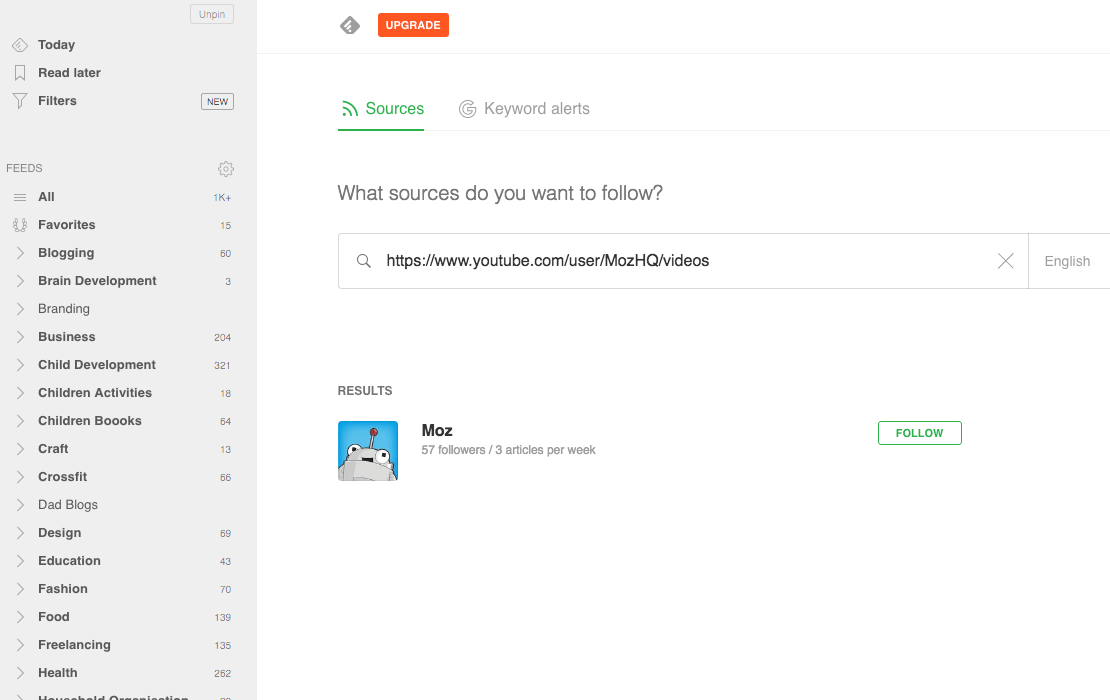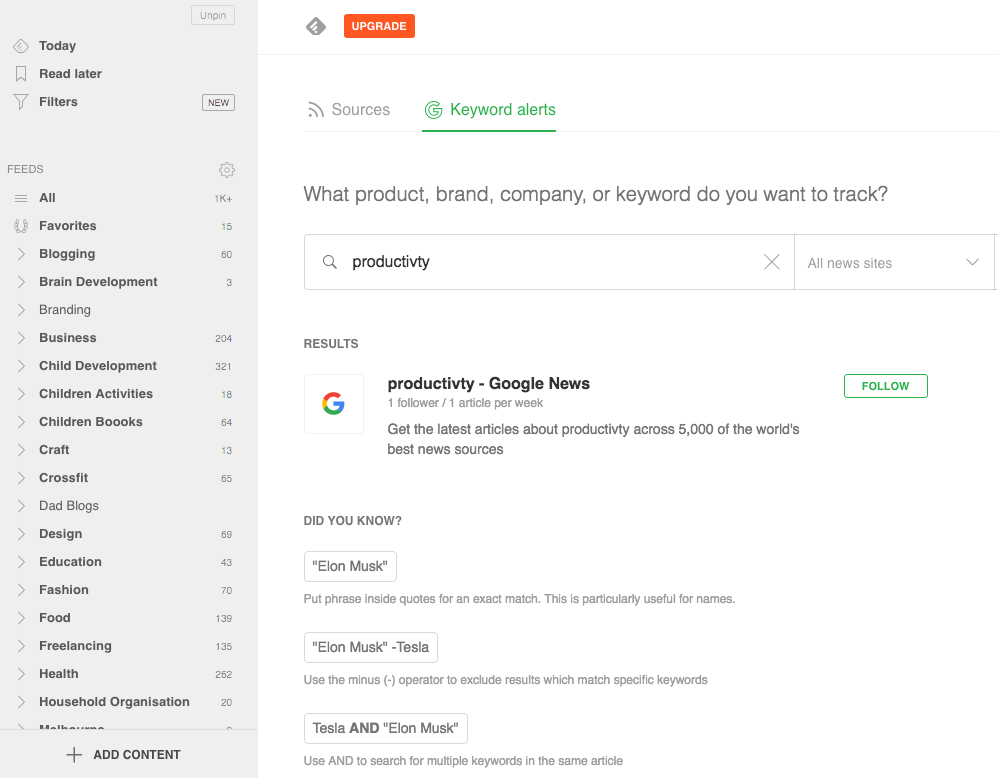 As bloggers, we create a significant amount of content. But most of us consume a significant amount of it as well.
As bloggers, we create a significant amount of content. But most of us consume a significant amount of it as well.
In an industry that uses strategies such as SEO, social media marketing and email marketing as key tools, we need to stay up to date with changes and trends so we can keep growing and developing. We also need to keep abreast of what’s happening in our niche to stay relevant.
Trouble is, with so much content out there we could easily spend our entire blogging work day consuming it. Sure we’re learning a lot, but we need to be mindful of how much time we’re spending and do it productively so it helps us grow our blogs.
Here are five tips to help you consume content more productively.
1. Focus
If you’ve been reading the productivity posts here on Problogger, then you’ll hopefully have set a goal for the year. If you have, you can use it to help target the type of content you read, watch and listen to. General knowledge is wonderful, and certainly has its place. But in terms of helping you with your blogging it’s far more productive to focus on content topics that will help you reach your blogging goal(s) for the year.
For example, if your goal is to increase newsletter subscribers then subscribing to podcasts and blogs that share content on this topic would be beneficial, as would reading books or listening to audiobooks that share list-building strategies.
It can be tempting to learn about every blogging issue to try and stay up to date. But this splits your attention, which means you can only go shallow on topics. You’re better off going deep and consuming content on fewer topics that will help you reach your goal than spreading your attention too thin.
2. Have the content come to you
You’ll always need to look for specific information. But if there are blogs, podcasts and vloggers you like to read, listen to and watch regularly, make sure you subscribe to them. That way the information comes to you, which you can then consume whenever it’s convenient.
There are plenty of great tools available to help you. Here are a few that work well for me.
feedly
feedly is a content aggregator that works on web browsers, as well as on iOS and Android devices through a free app. It lets you curate a news feed from a variety of online sources. You can add blogs, Youtube channels, and even Google keyword alerts that will gather the latest articles on your chosen topics from more than 5,000 of the world’s best news sources.
As you can see from the screenshot, it’s super easy to add new content.

To add a blog you like to read, simply click on the Add Content button and paste in the URL. You can also add your favourite YouTube video channels by pasting the URL into the space provided and clicking Follow.
With feedly you can scan through your preferred data sources without going to the actual source sites. This means you avoid all the distractions and ‘rabbit holes’ you can lose yourself in, helping you consume content more productively. It also means you can turn off things like Youtube notifications, as you’ll get the updates automatically in feedly.
Content aggregators such as feedly can also help you position yourself as a subject matter expert in a particular area. It can search the internet for your chosen keyword and retrieve articles from reputable news sources all over the world, rather than you having to do all the searching yourself. You can then either share these articles on your social media channel straight away, or use feedly’s Read Later function and mark content you want to save to share on your social media networks later.

Podcast apps
The podcast revolution continues, with so many amazing podcasts being published every day. Subscribing to podcasts in your niche, goal areas or areas of interest is an excellent way to manage incoming audio content.
If you use an Apple device you can use the native Podcast app. But with the changes they made to the app in iOS 11 I’m now looking at two other highly recommended podcast apps:
- Overcast, an iOS-only app available as either a free version with ads or a paid version with no ads.
- Pocket Casts, a paid app available on Android and iOS.
3. Take action notes
While it’s great to listen to podcasts and read blog posts and books on topics that will help you, unless you take action it’s not an effective use of your time. To ensure you put your new knowledge to use, or at least explore your thoughts and ideas on the content you consumed, take action notes.
Action notes are exactly what their name implies. After you’ve had a reading or listening session, write down the actions you’d like to take. They aren’t just general notes on things you heard or read, or quotes from the book. They’re specific action items you can take for your blog, based on the broad information you heard.
For example, if you’re focusing on increasing newsletter subscribers you may have found the Problogger podcast in your app and listened to Darren’s podcast on how to get more subscribers, follows and connections from your blog readers. With so much great information in this podcast you could easily write reams of notes. But Instead, try writing three actions you can take from what you’ve learned, such as:
- Create two more two opt-ins or lead magnets so they’ll be more relevant to readers, depending on the content they’ve been reading on the blog.
- Install a welcome mat, and track the impact on new subscribers.
- Write a series of blog posts, and encourage readers to subscribe so they get the latest posts in the series delivered to their inbox.
You can easily read and listen to huge amounts of information and not act on it. By keeping action notes in either your master planning document or a separate notebook, you can track and work through the action items you want to implement on your blog.
4. Share your thoughts
The best way to learn is to teach. Share your thoughts on what you’ve been reading, listening to or watching on your blog. Even if the information is different to your niche, you can build your own piece of content around it. You’ve been building a relationship with your audience, and they’ll be interested in your opinion and recommendations.
Gathering and sharing excellent content can be a great way to give value to your audience, and give purpose to the content you consume. Here are a few examples of bloggers sharing their thoughts on the content they’ve been consuming:
- Meet Me at Mikes – Something to read: Pip regularly shares what she’s been listening to, watching or reading. In this post she shares a host of things she’s been reading – from blogs and books to menus and recipes. It’s an eclectic collection that wonderfully reflects the personality of her blog, and shares information with readers they may not have found on their own.
- James Clear – Reading list: James is a prolific reader, and he writes super useful book summaries on his blog. James has collated his book reviews into a much-favourited and shared reading list, which breaks books into categories and top ten lists. In his full book reviews (like this one on Sapiens) he has three sections – the book in three sentences, the summary, and affiliate links to where you can buy the print, eBook and audiobook versions of the book. This reading list is a go-to reference guide for readers when they’re looking for a book to read.
- Becoming Minimalist – Inspiring Simplicity. Weekend Reads: Joshua Becker writes a weekly post sharing content he’s either watched, listened to or read on his simplicity/minimalism niche. The format is the same each week – a short introduction, and then one or two sentences on each item he shares. These posts are incredibly useful to his readers who are exploring and learning more about minimalism, and are consistently shared widely on social media. When I last checked, the post I’ve linked to had been shared more than a thousand times.
5. Use boundaries to limit your consumption
It can be hard to stop reading, watching or listening to content that’s stimulating, amusing or informative. But there’s a tipping point to how much content we can consume. Setting up personal boundaries can help ensure we take a productive approach to our consumption.
Look for pockets of time in your day where existing boundaries force you to stop. I schedule social media and blog reading in the last 30 minutes of my work day, when I pick the kids up from school. You may not have a school pick up to do, but you might have a meeting you can do some reading before, or a regular appointment that can act as a boundary and stop you spending too much time consuming and not enough time creating.
How do you manage the way you consume content? Tell us about it in the comments.
Photo by rawpixel.com on Unsplash
